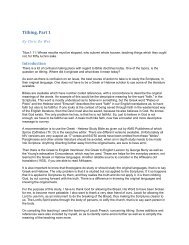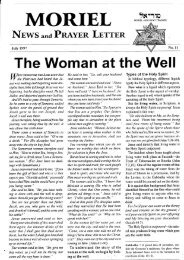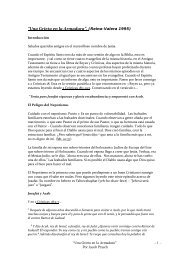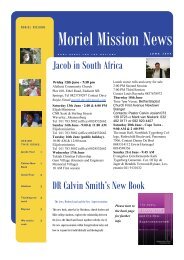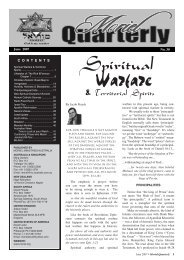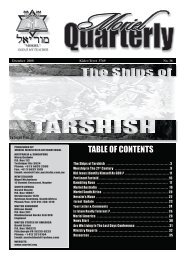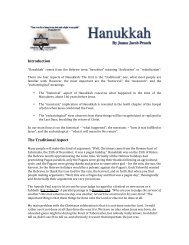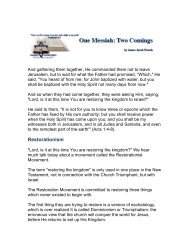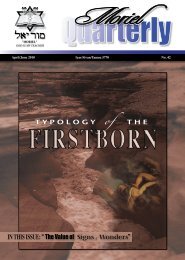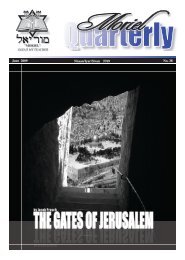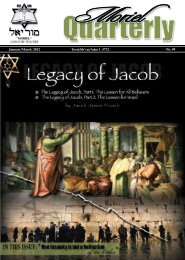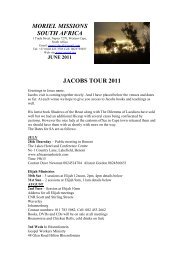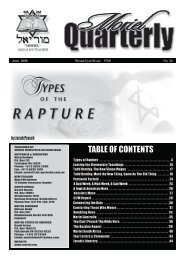The Scarlet Cord - Moriel Ministries
The Scarlet Cord - Moriel Ministries
The Scarlet Cord - Moriel Ministries
- No tags were found...
You also want an ePaper? Increase the reach of your titles
YUMPU automatically turns print PDFs into web optimized ePapers that Google loves.
Hebrew Feast<br />
Rosh Hashanah (Feast of Trumpets)<br />
(Hebrew<br />
, literally “head of the<br />
year”), is the Jewish New Year. It is the first<br />
of the High Holy Days or Yamim Nora’im<br />
(“Days of Awe”) which usually occur in the<br />
early autumn. Rosh Hashanah is celebrated<br />
on the first two days of Tishrei. It is described<br />
in the Torah as<br />
( Yo m<br />
Teru’ah, a day of sounding [the Shofar]).<br />
Rosh Hashanah customs include sounding<br />
the shofar and eating symbolic foods such<br />
as apples dipped in honey.<br />
Etymology<br />
<strong>The</strong> term “Rosh Hashanah” does not appear<br />
in the Torah. Leviticus 23:24 refers to<br />
the festival of the first day of the seventh<br />
month as “Zikhron Teru’ah” (“a memorial<br />
with the blowing of horns”), it is also referred<br />
to in the same part of Leviticus as<br />
‘ ’ or penultimate Sabbath or<br />
meditative rest day, and a “holy day to<br />
God”. <strong>The</strong>se same words are commonly<br />
used in the Psalms to refer to the anointed<br />
days. Numbers 29:1 calls the festival Yom<br />
Teru’ah, (“Day [of] blowing [the horn]”)<br />
and symbolizes a number of subjects, such<br />
as the Binding of Isaac and the animal sacrifices<br />
that were to be performed. (<strong>The</strong> term<br />
Rosh Hashanah appears once in the Bible<br />
in Ezekiel 40:1 where it means generally<br />
the time of the “beginning of the year” or is<br />
possibly a reference to Yom Kipur,[2] but<br />
the phrase may also refer to the month of<br />
Nissan in the spring, especially in light of<br />
Exodus 12:2 where the month of Nissan is<br />
stated as being “the first month of the year”<br />
and Ezekiel 45:18 where “the first month”<br />
unambiguously refers to Nissan, the month<br />
of Passover, as made plain by Ezekiel 45:21.<br />
<strong>The</strong> Hebrew Rosh Ha-Shanah is etymologically<br />
related to the Arabic Ras as-Sanah,<br />
the name chosen by Muslim lawmakers for<br />
the Islamic New Year, reflecting the Islamic<br />
immitation of older Jewish traditions. Pre-<br />
Islamic mid-eastern cultures, besides the<br />
Jews, did not use this unique name, e.g.,<br />
Egypt, Persia or Babylon. Rosh Hashanah<br />
Hasidic Jews performing tashlikh on<br />
Rosh Hashanah, painting by Aleksander<br />
Gierymski, 1884<br />
marks the start of a new year in the Hebrew<br />
calendar (one of four “new year” observances<br />
that define various legal “years”<br />
for different purposes as explained in the<br />
Mishnah and Talmud). It is the new year for<br />
people, animals, and legal contracts. <strong>The</strong><br />
Mishnah also sets this day aside as the new<br />
year for calculating calendar years, shmita<br />
and yovel years. Jews are confident, that<br />
Rosh Hashanah represents either figuratively<br />
or literally God’s creation ex nihilo.<br />
However, according to Rabbi Eleazar ben<br />
Shammua Rosh Hashanah commemorates<br />
the creation of man.<br />
Shofar blowing<br />
Yemenite-style shofar<br />
Laws on the form and use of the shofar<br />
and laws related to the religious services<br />
during the festival of Rosh Hashanah are<br />
described in Rabbinic literature such as the<br />
Mishnah that formed the basis of the tractate<br />
“Rosh HaShanah” in both the Babylonian<br />
Talmud and the Jerusalem Talmud.<br />
This also contains the most important rules<br />
concerning the calendar year. <strong>The</strong> shofar is<br />
blown in long, short and staccato blasts that<br />
follow a set sequence:<br />
• Teki’ah (long sound) Numbers 10:3<br />
• Shevarim (3 broken sounds) Numbers 10:5<br />
• Teru’ah (9 short sounds) Numbers 10:9<br />
• Teki’ah Gedolah (very long sound) Exodus<br />
19:16,19<br />
• Shevarim Teru’ah (3 broken sounds followed<br />
by 9 short sounds)<br />
Duration and timing<br />
• Rosh Hashanah occurs 163 days after the<br />
first day of Passover (Pesach). In terms of<br />
the Gregorian calendar, the earliest date<br />
on which Rosh Hashanah can fall is September<br />
5, as happened in 1899 and will<br />
happen again in 2013. <strong>The</strong> latest date that<br />
Rosh Hashanah can occur relative to the<br />
Gregorian dates is October 5, as happened<br />
in 1967 and will happen again in 2043.<br />
After 2089, the differences between the<br />
Hebrew calendar and the Gregorian calendar<br />
will result in Rosh Hashanah falling<br />
no earlier than September 6.<br />
• Rosh Hashanah will occur on the following<br />
days of the Gregorian calendar:<br />
• Current Jewish Year 5773: sunset September<br />
16, 2012 - nightfall September 18, 2012<br />
• Coming Jewish Year 5774: sunset September<br />
4, 2013 - nightfall September 6, 2013<br />
• Although the Jewish calendar is based on<br />
the lunar cycle, so that the first day of<br />
each month originally began with the first<br />
sighting of a new moon, since the fourth<br />
century it has been arranged so that Rosh<br />
Hashanah never falls on a Wednesday,<br />
Friday, or Sunday.<br />
• <strong>The</strong> Torah defines Rosh Hashanah as a<br />
one day celebration, and since days in the<br />
Hebrew calendar begin at sundown, the<br />
beginning of Rosh Hashanah is at sundown<br />
at the end of 29 Elul. <strong>The</strong> rules of the Hebrew<br />
calendar are designed such that the<br />
first day of Rosh Hashanah will never occur<br />
on the first, fourth, or sixth day of the<br />
Jewish week (i.e., Sunday, Wednesday, or<br />
Friday). Since the time of the destruction<br />
of the Second Temple of Jerusalem in 70<br />
CE and the time of Rabban Yohanan ben<br />
Zakkai, normative Jewish law appears to<br />
be that Rosh Hashanah is to be celebrated<br />
for two days, due to the difficulty of determining<br />
the date of the new moon. Nonetheless,<br />
there is some evidence that Rosh<br />
Hashanah was celebrated on a single day<br />
in Israel as late as the thirteenth century<br />
CE. Orthodox and Conservative Judaism<br />
now generally observe Rosh Hashanah<br />
for the first two days of Tishrei, even in<br />
Israel where all other Jewish holidays<br />
dated from the new moon last only one<br />
day. <strong>The</strong> two days of Rosh Hashanah are<br />
said to constitute “Yoma Arichtah” (Aramaic:<br />
“one long day”). In Reform Judaism,<br />
some communities only observe the<br />
first day of Rosh Hashanah, while others<br />
observe two days. Karaite Jews, who do<br />
not recognize Rabbinic Jewish oral law<br />
and rely on their own understanding of<br />
the Torah, observe only one day on the<br />
first of Tishrei, since the second day is not<br />
mentioned in the Written Torah.<br />
(Wikipedia)<br />
Feast of Trumpets<br />
30 <strong>Moriel</strong> Quarterly • September 2012




